MQ-8Cs loaded with sonobuoys could help speed up searches for enemy submarines while reducing the workload on human personnel

Northrop Grumman has revealed that it conducted an anti-submarine warfare test last year involving a surrogate for its MQ-8C Fire Scout drone helicopter equipped to drop sonobuoys. This comes amid a resurgence in interest in submarine-hunting capabilities within the U.S. military, as well as its allies, in recent years, as potential underwater threats, especially from Russia and China, continue to grow.
The maritime division of U.K.-based firm Ultra, which provided the sonobuoys and related signal processing systems, worked with Northrop Grumman on the test, which took place on Oct. 29, 2020, off the coast of southern California. A modified manned Bell 407 helicopter stood in for an MQ-8C during this event. This variant of the Fire Scout is based on the Bell 407 design.
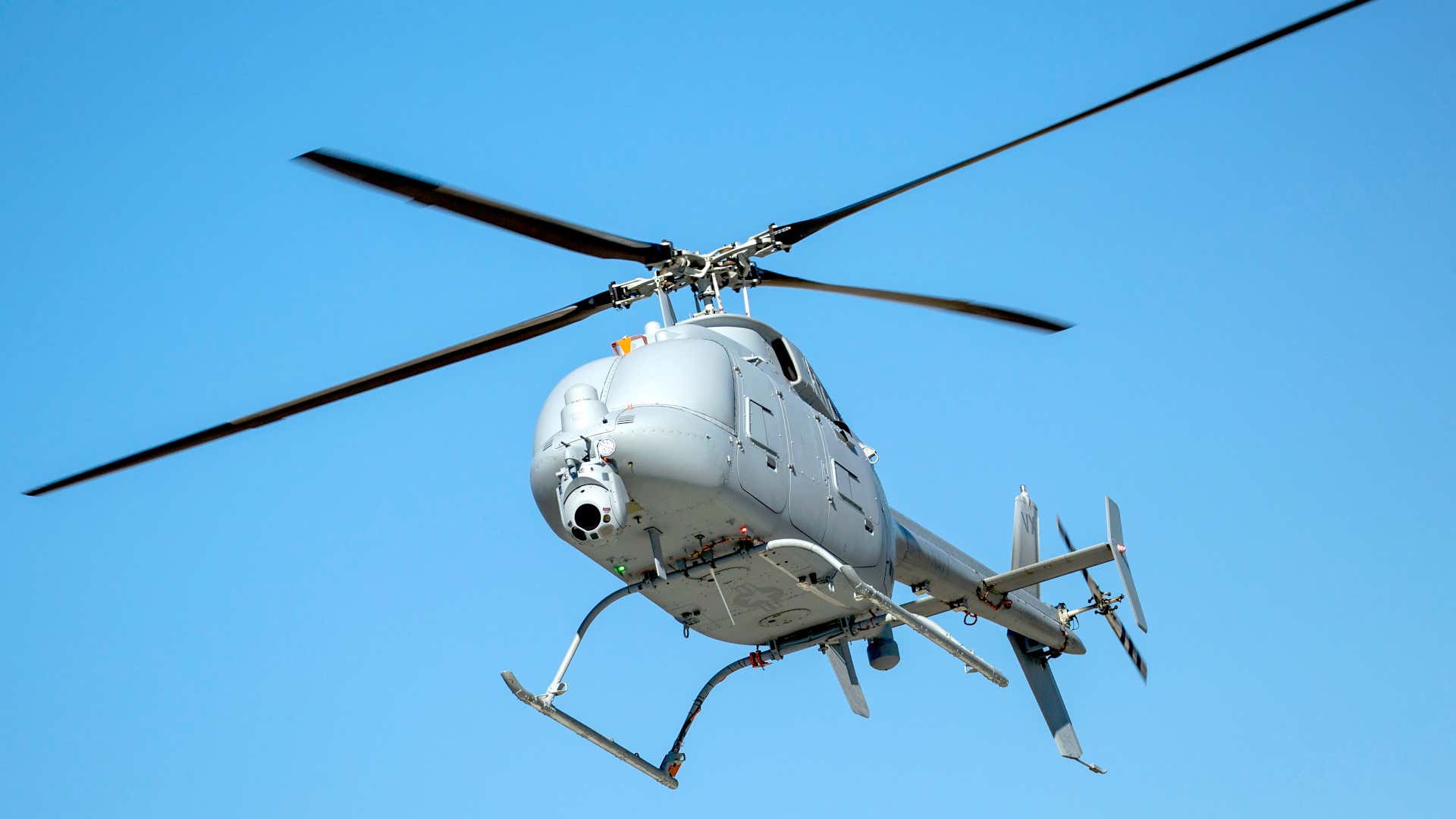
An MQ-8C Fire Scout drone helicopter.
“Adding an ASW [anti-submarine warfare] capability to Fire Scout’s existing multi-mission capabilities would further enhance this highly-versatile platform,” Dan Redman, Northrop Grumman's Fire Scout Maritime Mission Expansion Lead, said in a statement. “This ASW capability would offer commanders flexibility to employ not only UAS systems in this particular ASW role, but also utilize the increased availability of crewed aircraft more incisively against an expanded mission set. This would increase the total available effect of the manned/unmanned teamed force mix.”
“Operating prototype hardware in a high-pressure real-world environment can be challenging,” Thomas Link, the President of Ultra Maritime, added in the same press release. “Our partnership will bring an innovative and leading ASW capability into operation, combining both manned and unmanned ASW systems that will help defend our warfighters and provide increased capability to our forces.”
It's not clear what type or types of sonobuoys the surrogate helicopter deployed during the test, or how many it dropped in total. Northrop Grumman has released concept art, seen at the top of this story, showing an MQ-8C carrying two dispenser pods, each with 24 cells, on a plank-type mounting system running through the center of the fuselage. However, a picture the company released from the October demonstration, seen below, indicates that the surrogate helicopter carried a single dispenser system under the central fuselage.
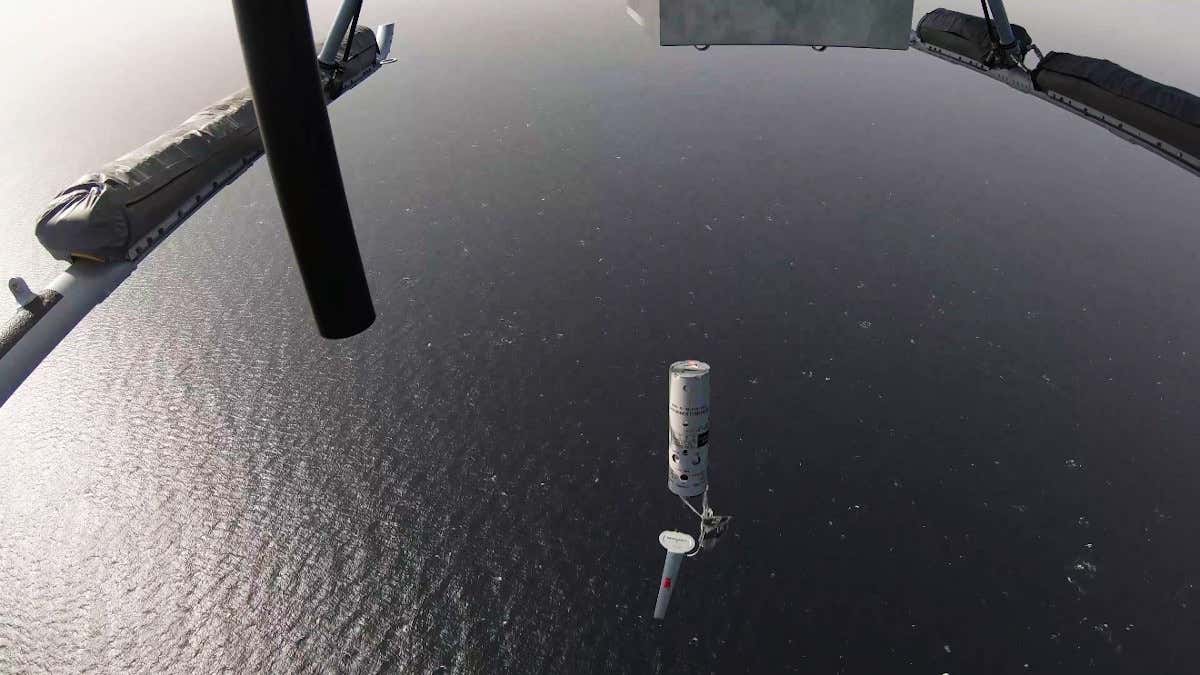
A Bell 407 helicopter acting a surrogate for an MQ-8C drone drops a sonobuoy during a test in October 2020.
Northrop Grumman did say the sonobuoys were "used to conduct a large area multistatic acoustic search." Ultra offers multiple types of multistatic acoustic sonobuoys with active or passive sonars. "Ultra makes about 90% of all the sonobuoys used in the West," Redman, the Northrop Grumman's Fire Scout Maritime Mission Expansion Lead, told Jane's in a subsequent interview.
Passive types have sensors to passively gather acoustic data, while active sonobuoys send out sonar "pings" to search for submarines and other objects of interest underwater. You can read more about how sonobuoys are employed in hunting for enemy submarines in this previous War Zone story.
"The mission payload and effects were controlled from the ground with the resultant ASW picture disseminated to locations across the globe," Northrop Grumman added in their press release. The company said that the U.S. Navy was not directly involved in the test and "has not yet identified a clear requirement for UAS [unmanned aviation systems] ASW capability," but "has shown interest in the development and continues to support and monitor progress."
This overall test is similar in many respects to one that General Atomics carried out off the coast of Southern California in November of last year, which you can read more about in this past War Zone piece. In that instance, an MQ-9A Reaper dropped three different kinds of sonobuoys, including ones with active and passive sonars, as well as a bathythermograph type designed to detect objects through changes in water temperature, during a simulated search for an enemy submarine.
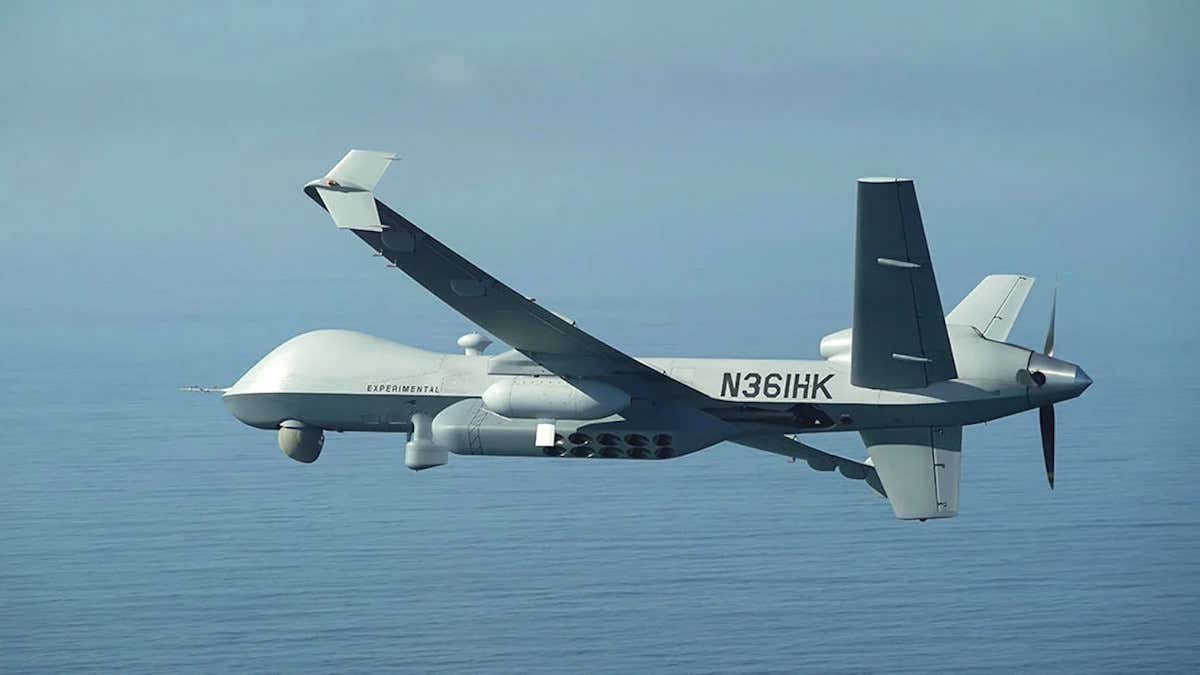
An MQ-9A Reaper drone with a sonobuoy dispenser under its wing during an anti-submarine warfare demonstration in November 2020.
There are significant potential benefits to adding the ability to drop sonobuoys, as well as process and disseminate the information they collect, to the MQ-8C. This version of the Fire Scout, a completely different design from the earlier MQ-8B, which is larger and more capable, is presently configured to perform intelligence, surveillance, and reconnaissance (ISR) and help acquire targets for other platforms, as well as support command and control and communications relay missions. Northrop Grumman says the drone helicopter can remain airborne for at least 12 hours at time.
The Navy, which declared initial operational capability with the MQ-8C in 2019, typically deploys these drones together with manned MH-60R Seahawk helicopters on various types of warships. The Seahawk helicopters can also deploy sonobuoys, as well as hunt for submarines using dipping sonar. They are also now slated to receive magnetic anomaly detectors (MAD), which will offer another means of detecting potential underwater threats.
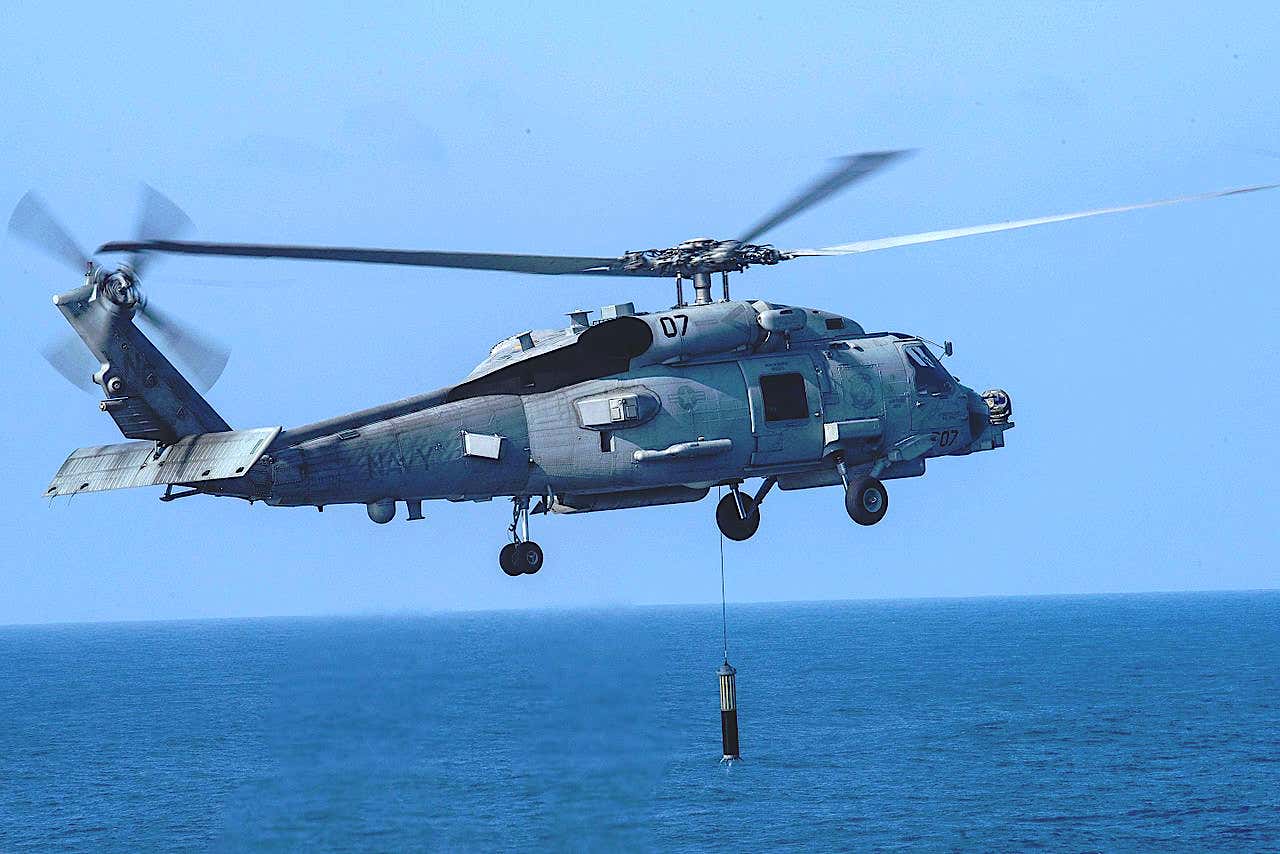
An MH-60R Seahawk helicopter employs a dipping sonar system.
MQ-8Cs loaded with sonobuoys would offer a way to more rapidly expand the size of the overall array, making it more difficult for a hostile submarine to escape. The buoys also have limited battery life and there is a need to reseed arrays during protracted operations, another role an anti-submarine warfare Fire Scout could assist with. All of this, of course, could free up manned MH-60R helicopters, as well as the crews of other anti-submarine warfare aircraft and ships on the scene, to focus on specific contacts. A single MH-60R can only be in one place at once, as well, so MQ-8Cs being able to help at all would add valuable additional submarine-hunting capacity, too.
Improvements in artificial intelligence and machine learning could help the MQ-8Cs process the data they receive from the sonobuoy arrays and do so rapidly. This could also allow them to weed out unwanted data and false positives before even passing anything along to human anti-submarine warfare personnel, reducing their workload and otherwise speeding up the search process.
There's also the possibility that MQ-8Cs could prosecute threats directly, either with some some level of engagement from a human operator or entirely autonomously based on a defined set of parameters. Northrop Grumman has already demonstrated the ability of a Bell 407 helicopter acting as a surrogate for a Fire Scout to employ a miniature torpedo, which you can read about in more detail in this past War Zone piece.
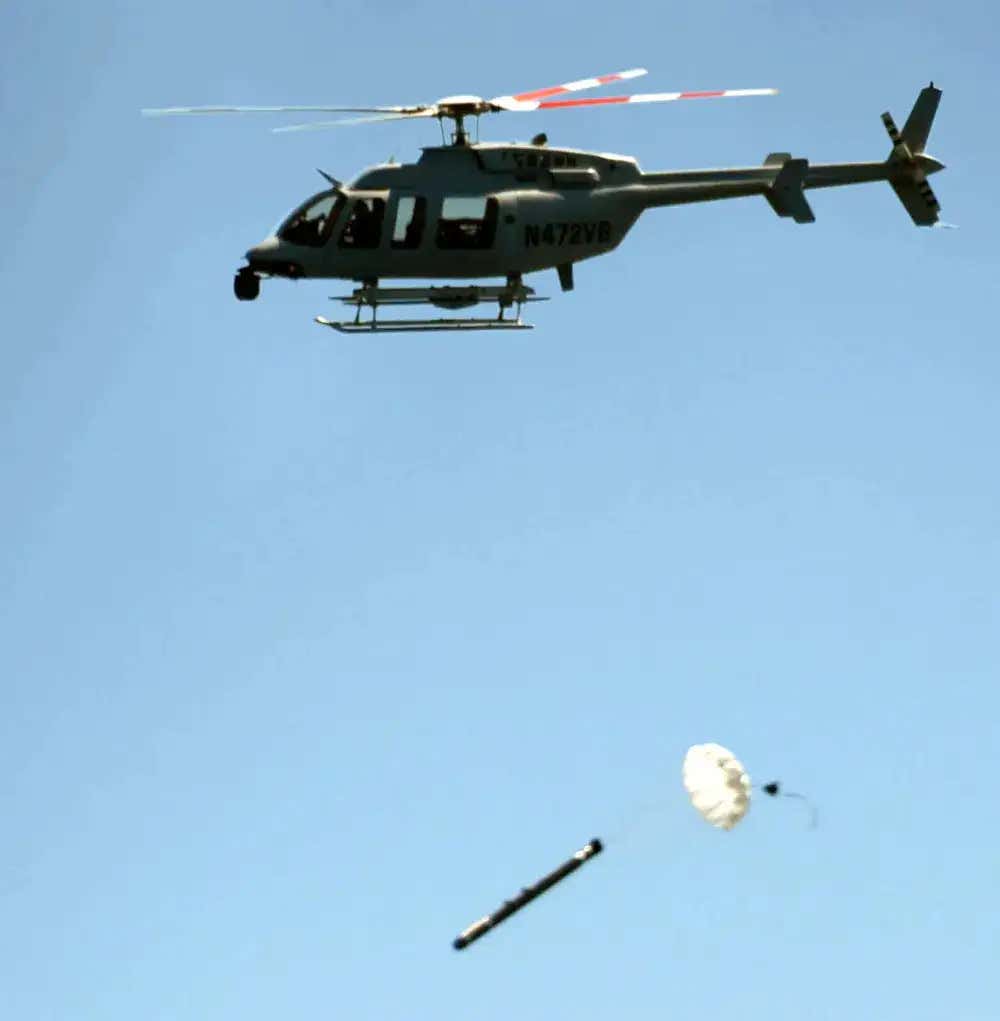
A Bell 407 helicopter drops an experimental miniature torpedo during a demonstration in 2016.
Regardless of how interested the Navy may be in adding anti-submarine warfare capabilities to its MQ-8Cs now, the service is only looking to expand its arsenal in this regard in general, amid concerns about the growing threat of Russian and Chinese submarine fleets and other underwater capabilities. These two countries, among other potential adversaries, are working steadily to expanding their undersea fleets, including with more modern types designed specifically to be quieter, and, as a result, harder to detect and track underwater.
It is interesting to note that the Navy recently announced its desire to acquire a replacement for its MQ-8B and C Fire Scouts, as well as its MH-60R and S Seahawks, starting in the mid-2030s. Anti-submarine warfare was one of the mission sets that the service said it was looking for any future manned or unmanned helicopter to perform.
Still, an anti-submarine warfare kit for the MQ-8C could be a very viable way to expand the Navy's sub-hunting capabilities in the near term.

Submarine Hunting Kit Will Let MQ-8C Fire Scout Drone Helicopters Launch Sonobuoys
MQ-8Cs loaded with sonobuoys could help speed up searches for enemy submarines while reducing the workload on human personnel.


